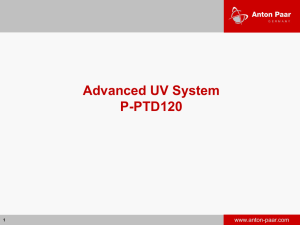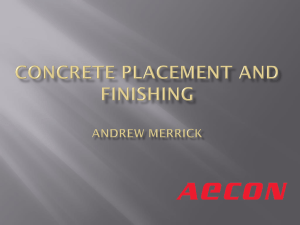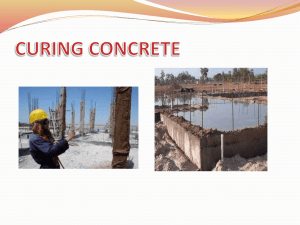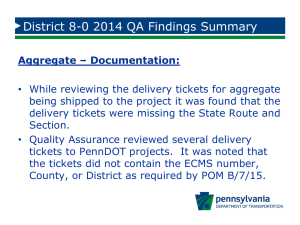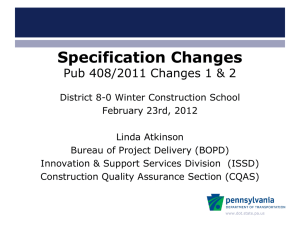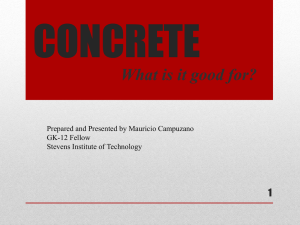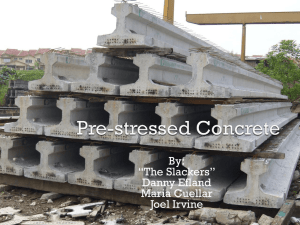Curing and protection of concrete
advertisement
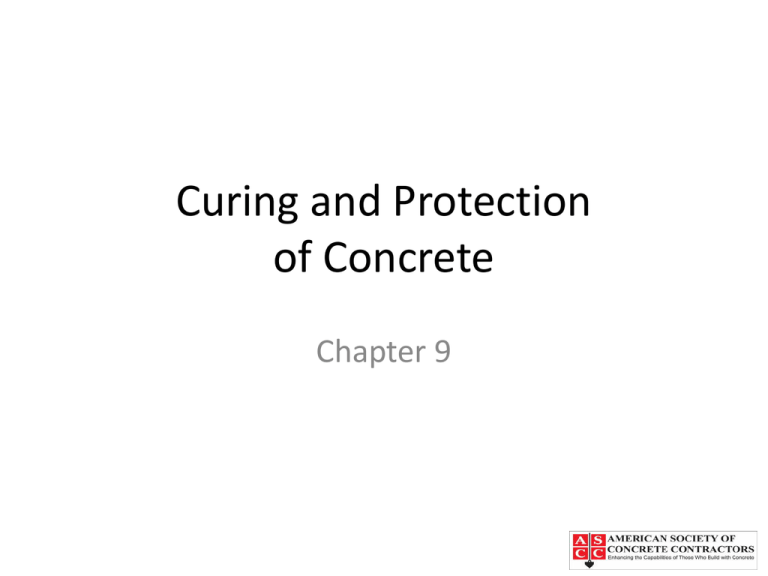
Curing and Protection of Concrete Chapter 9 Chapter Topics • • • • • Importance of curing When to start curing Curing methods Effects of high temperature on concrete Causes and prevention of plastic shrinkage cracking • Effects of low temperatures on concrete Curing • Curing refers to the methods used to keep concrete moist and at the temperature needed to develop the required strength, wear resistance, and durability. • The main concern is preventing moisture loss from the slab surface, especially at early ages. • Controlling this loss may require actions any time after placement, including before and after final finishing. Importance of Curing • Hydration is the hardening of concrete due depends on a chemical reaction between the cement and water. • The speed of hydration depends on temperature, but hydration also calls for moisture to be present. • Right conditions for curing involves three factors: – Moisture – Temperature – Time Moisture for Curing • Hydration of cement slows as concrete dries. • That is why slab surfaces must be kept from drying in the first several days after placement. • If the water is kept in the concrete, hydration will continue, but if all the free water evaporates, hydration practically stops. • Protect the concrete surface either by applying water or preventing evaporation When to Start Curing • In hot weather, it’s important to start curing very quickly. • Curing may have to start after placing and before finishing is completed by using fog sprays or evaporation reducers. • To minimize plastic shrinkage cracks, take steps to reduce evaporation during finishing operations and for several days thereafter. • Planning so fogging nozzles, evaporation reducers, or both are available and ready for use before the concrete arrives. Curing Methods • Ponding • Sprinkling or fog spraying • Wet burlap or mats • Reinforced paper of plastic films • Curing compounds Curing Compounds • Forms a film to seal in moisture • 150 to 200 ft2 per gallon • White or gray colors added to curing compounds to reflect sunlight and show that the compound is being uniformly applied. • Don’t use on surfaces that will be covered with concrete, mortar, tile, many floor coverings, or paint, unless tests show that the compound can be adequately removed or the manufacturer states in writing that it will not weaken the bond between the slab and the covering. Effects of High Temperature • Hot weather precautions – Use concrete mix that works for hot weather – Select a concrete slump for rapid placement and consolidation – Place and finish concrete as fast as possible – Schedule night pours – Protect against moisture loss at all times Plastic Shrinkage Cracking • Form while the concrete is soft or plastic, usually soon after concrete is placed. • Occurs when the slab surface is drying faster than the bleed water is rising to the surface. • Plastic shrinkage cracks are most likely to appear when the concrete is warm, and the weather is dry (low relative humidity), windy, and/or hot. Plastic Shrinkage Cracking • To determine evaporation rate – – – – Concrete temperature Air temperature Wind speed Relative humidity • When the rate of evaporation exceeds about 0.2 lb of water/ft2/hour, plastic shrinkage cracking may occur. • With concrete that doesn’t bleed much, plastic shrinkage cracking can occur at evaporation rates lower than 0.2 lb of water/ft2/hour. Minimize Plastic Shrinkage Cracking • Dampen subgrade and forms • Protect against drying – Fog spraying – Evaporation retarders – Plastic sheets or wet burlap • Erect windbreaks if possible • Place concrete in an enclosed building • Avoid placing in hot, windy weather Effects of Low Temperatures • Time to start floating – 2 ½ hours at 60F – 3 ½ hours at 40F – 5 hours at 35F • Early strength gain is very slow at temperatures below 50 °F • Curing period must be extended to attain a certain strength Effects of Low Temperatures • Placing warm concrete on a cold subgrade can result in some problems that are very difficult to solve. • Concrete in contact with the subgrade will cool rapidly, remain plastic, and might still be bleeding while concrete at the surface will set and beginning to harden. • A “crust” forms at the surface just as the slab is ready to be floated and troweled. • When the workers walk on the slab, the concrete feels rubbery, and it’s difficult to obtain a flat and level surface during finishing. • Bleed water can also collect beneath the crust and form a plane of weakness that may cause the surface to delaminate under traffic. • It’s best to place warm concrete on a subgrade that has a temperature no more than 30°F less than the concrete temperature. Precautions Against Freezing • Protect concrete when temperatures are below 40F • Concrete needs to be above 500 psi • Takes 1 day of curing at about 50F to reach 500 psi • Corners and edges most vulnerable to freezing Protection Against Freezing • Use insulating blankets • Place concrete in heated enclosures • Use accelerating admixtures – Calcium chloride if not steel – Non-chloride accelerator if steel • Use extra cement • Use Type III cement Air-Drying of Slabs after Curing • It’s good practice to permit outdoor slabs in cold climates to dry for as long as possible, preferably 30 days after curing. • Drying reduces moisture content and thus the danger of damage caused by freezing saturated concrete. • Avoid using deicing salts until the concrete has dried and has been through one winter.

